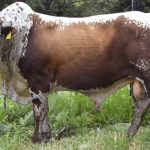ZIMBABWE HERD BOOK-YEAR OF THE NKONE 2023
NEWSLETTER FROM HHN and MH NKONE STUDS
No 2 (9th OCTOBER 2022)
By SEKURU
Higher temperatures and the hot, gusty September/October winds are here again and hopefully our first rains are about 6 weeks away now. This is veld fire time and we should all have made preparations such as strategically placed fire guards and created a general awareness amongst everyone involved of the dangers and need to be careful, watchful and know what to do in the event of a fire. Every year, hundreds of thousands of hectares of valuable grazing is burnt by wilful, carelessly started and unnecessary fires. Stockowners can lose all their grazing in a matter of a few hours, to be left with nothing, having to find grazing elsewhere (very difficult at this time of the year) or purchase food at great cost or sell off cattle.
Driving out to the cattle earlier this week, there are still a few small patches of Msasa woodland left amongst the ever-increasing mass of housing development taking place, some new and smart and others squalid shacks. Most of the Msasa trees are now different shades of soft, lovely greens. They have just ended that glorious new-leaf stage of reds, oranges, browns and yellows with many beautiful colours in between. I was fortunate to travel along the Mutare road twice in the last six weeks when they were at the height of their awesome beauty, making me stop and just absorb and enjoy it all. And of course, not forgetting the amazing Jacaranda flowers!

We have just completed renovating our very old handling facilities which had become almost non functional and not a pleasure to work in. It cost us a few young sale bulls but has made things much easier and less stressful for herdsmen, cattle and ourselves. Operations are now carried out in half the time and quiet, calm cattle can get back to grazing in good time. We incorporated a Bud Box at the entrance to the race on recommendations from two of the many first-class cattlewomen we know, Mandy Langton and Maree Osborne. The Bud Box has complemented our overall design for “easy flow” of the cattle, no more bunching and bottlenecks at the race entrance, just a quiet and easy flow of cattle until the race is full. Just Google “Bud Box for cattle” and you will find designs and dimensions, don’t go larger than the recommended size. Ours is 6,8m x 3,4m and rectangular. It is an essential part of any cattle handling facility if used correctly.
With the new facilities, it has become necessary to get together with the herdsmen and review our cattle handling, which had become slack and not conducive to stress-free working conditions, both for the cattle, the herdsmen and ourselves! Noise, shouting, frenzied waving of sticks or arms, and unnecessary rushing around has been banned. We now take it slow and easy and work with the new design, this had reduced stress and saves a lot of time. It is also important for those handling cattle to know the basics of positioning oneself in relation to the animals, encouraging them to take, and not refuse, the direction in which you want them to move. For example, when cattle are in a race and you want them to move forward, start from the front and walk past the animals, down the race towards the rear and they will immediately move forward, followed by others as you continue to go down the line.
Move cattle around the pens in smaller groups, say 12 to 15 head, they are easier to control and won’t bunch up and mill around blocking forward progress. We find it is useful to keep cattle in groups of 15-18 which is race full in our system. Once a group has been moved to the next stage it is easy to return and collect another similar sized group which will immediately follow on.
Our Nkone are naturally very docile and easy to handle from thousands of years of herding and living in close proximity to people, but it is still well worth having good facilities and well-trained handlers to keep them relaxed, when they will do better. Contented cattle are productive cattle.
In these days of having to herd and night-kraal our commercial breeding cattle, the Nkone are well adapted to the system. They naturally fill their bellies in a short time when on grazing even on sour coarse grasses, and their high natural internal urea levels enable them to digest the poor grazing more efficiently. Common sense and efficient herding methods are essential to make the most of the grazing time and the best grazing. The importance of this cannot be overstressed, your cows’ production depends entirely on the level of nutrition and their wellbeing, and this is important every day of the year. Our herdsman must be highly efficient, adequately paid, well trained people who understand the basic principles of nutrition and cattle management and are able to care for your cattle’s daily needs accordingly, to achieve maximum production.
Inherent Body Condition + Hormonal Balance = Fertility
Adaptability +Functional Efficiency + Fertility = Profit – P.J. Budler.










